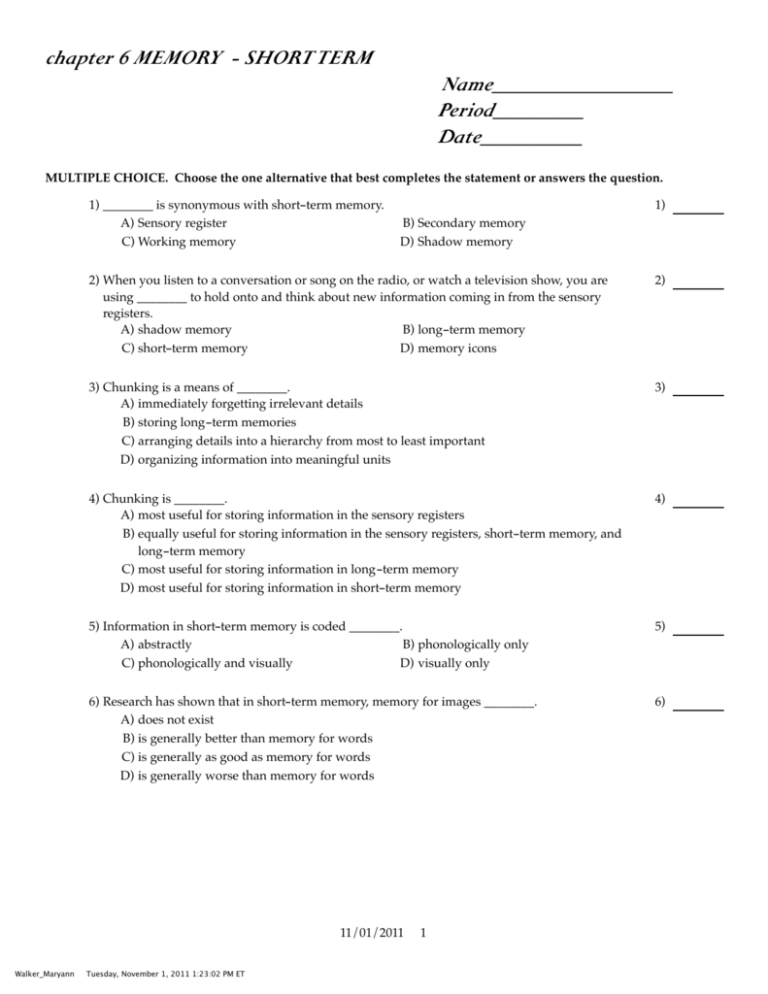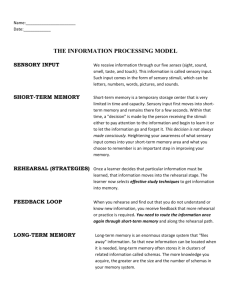chapter 6 MEMORY
advertisement

chapter 6 MEMORY - SHORT TERM Name________________ Period________ Date_________ MULTIPLE CHOICE. Choose the one alternative that best completes the statement or answers the question. 1) ________ is synonymous with short-term memory. A) Sensory register C) Working memory 1) B) Secondary memory D) Shadow memory 2) When you listen to a conversation or song on the radio, or watch a television show, you are using ________ to hold onto and think about new information coming in from the sensory registers. A) shadow memory B) long-term memory C) short-term memory D) memory icons 2) 3) Chunking is a means of ________. A) immediately forgetting irrelevant details B) storing long-term memories C) arranging details into a hierarchy from most to least important D) organizing information into meaningful units 3) 4) Chunking is ________. A) most useful for storing information in the sensory registers B) equally useful for storing information in the sensory registers, short-term memory, and long-term memory C) most useful for storing information in long-term memory D) most useful for storing information in short-term memory 4) 5) Information in short-term memory is coded ________. A) abstractly B) phonologically only C) phonologically and visually D) visually only 5) 6) Research has shown that in short-term memory, memory for images ________. A) does not exist B) is generally better than memory for words C) is generally as good as memory for words D) is generally worse than memory for words 6) 11/01/2011 Walker_Maryann Tuesday, November 1, 2011 1:23:02 PM ET 1 7) Arnie finally got the telephone number of a girl he's been wanting to ask out for a date. Unfortunately, he had nothing to write the number on when it was told to him. To keep from forgetting the number, he simply repeats it aloud until he can find a pen and some paper. His memory tactic is called ________. A) deep processing B) distractor inhibition C) elaborative rehearsal D) rote rehearsal 7) 8) Rote rehearsal is also called ________. A) deep processing C) elaborative rehearsal 8) B) chunking D) maintenance rehearsal 9) What we are thinking of at any given moment, or what we commonly know as “consciousness,” is ________. A) cognitive dissonance B) short-term memory C) long-term memory D) secondary memory 10) Material stored in short-term memory remains there for about ________ and then fades unless rehearsed or practiced. A) a few seconds B) several minutes C) one second D) 1/4 of a second 10) 11) If you want to remember something for a couple of minutes, the MOST effective device is ________. A) visual imagery B) tactile imagery C) rote rehearsal D) elaborative rehearsal 11) 12) The two primary tasks of short-term memory are to ________. A) store information permanently and to process how meaningful that information is B) hold on to information just long enough to begin initial processing by the nervous system and to selectively filter out irrelevant information C) store information permanently and to work on that (and other) information D) store information briefly and to work on that (and other) information 12) 13) When we are pricing items in a grocery store, and we attempt to remember the prices of three different brands of 7-ounce cans of tuna fish by repeating them again and again, the information is being held in ________. A) the sensory registers B) short-term memory C) secondary memory D) long-term memory 13) 14) Short-term memory can hold ________ for ________. A) a vast number of items; a matter of seconds B) a vast number of items; many years C) only a few items; many years D) only a few items; a matter of seconds 14) 2 Walker_Maryann 9) Tuesday, November 1, 2011 1:23:02 PM ET 15) The fact that people recognize that M and M are the same letter faster than they recognize that M and m are the same letter is evidence that ________. A) most verbal material in short-term memory is stored phonologically B) only through elaborative rehearsal can material be committed to long-term memory C) some verbal material in short-term memory is stored in visual form D) rote rehearsal helps to store information in short-term memory 15) 16) Rotating an M until it is recognized as a W is evidence that we can process information in ________. A) short-term memory visually B) long-term memory visually C) short-term memory phonologically D) long-term memory phonologically 16) 17) You look up a telephone number in the directory. You find the name and the number: 3531416. For a split second, the image of the number resides in ________. The image fades quickly, yet you manage to keep the number in ________ through ________. A) the sensory register; LTM; mnemonics B) the sensory register; the sensory register; rote rehearsal C) STM; LTM; rote rehearsal D) the sensory register; STM; rote rehearsal 17) 18) Different domain specific memory systems ________. A) can operate at the same time with very little interference B) can operate at the same time, but greatly interfere with each other C) cannot operate at the same time D) can operate at the same time, but moderately interfere with each other 18) 19) When two memory tasks are presented in different sensory modalities (for instance visual and auditory) ________. A) they are equally as likely to interfere with each other as if they are in the same modality B) they are less likely to interfere with each other than if they are in the same modality C) they are more likely to interfere with each other than if they are in the same modality D) it becomes impossible to accomplish either task efficiently 19) 20) It is easier to remember the names of seven people you just met at a party than it is to remember their addresses (even if both pieces of information were given to you at the same time), because there is a(n)________. A) direct relationship between the size of the chunks in short-term memory and their retention B) inverse relationship between the size of the chunks in short-term memory and their retention C) direct relationship between the size of the chunks in the sensory registers and their retention D) inverse relationship between the number of items in the sensory registers and their retention 20) 3 Walker_Maryann Tuesday, November 1, 2011 1:23:02 PM ET 21) Which of the following statements about short-term memory is NOT true? A) The critical factor for recall in short-term memory is the number of meaningful units involved. B) As the size of each chunk increases, the number of chunks that can be recalled declines. C) The ability to work on information competes constantly with the ability to store new information for a short time. D) Single words are harder to remember than phrases and sentences. 21) 22) The most accurate description of short-term memory's capacity is probably to say that it can hold ________. A) between 5 and 10 bits of information B) as much information as can be heard in 1 to 4 seconds C) as much information as can be rehearsed in 1.5 to 2 seconds D) as much information as can be read in 3 to 5 seconds 22) 23) It is now believed that short-term memory can hold as much information as can be repeated or rehearsed in ________ seconds. A) 2.0 - 3.5 B) 0.5 - 1.5 C) 1.5 - 2.0 D) 3.5 - 5.0 23) TRUE/FALSE. Write 'T' if the statement is true and 'F' if the statement is false. 24) Grouping and organizing information so that it fits into meaningful units is called chunking. 24) 25) Recent research suggests that short-term memory can hold as much information as long-term memory. 25) 26) Short-term memory usually has only one task to perform at a time. 26) 27) The capacity for short-term memory is greater with visual coding than acoustical coding. 27) 28) Words or letters that we see are coded visually (not verbally) in short-term memory. 28) 4 Walker_Maryann Tuesday, November 1, 2011 1:23:02 PM ET Answer Key Testname: CH 6 MEMORY ST ONLINE QUIZ 1) C Page Ref: 190 2) C Page Ref: 190 3) D Page Ref: 191 4) D Page Ref: 191 5) C Page Ref: 192 6) B Page Ref: 192 7) D Page Ref: 192 8) D Page Ref: 192 9) B Page Ref: 190 10) A Page Ref: 192 11) C Page Ref: 192 12) D Page Ref: 190 13) B Page Ref: 192 14) D Page Ref: 192 15) C Page Ref: 192 16) A Page Ref: 192 17) D Page Ref: 190-192 18) A Page Ref: 192 19) B Page Ref: 192 20) B Page Ref: 192 21) D Page Ref: 192 22) C Page Ref: 191 23) C Page Ref: 191 11/01/2011 Walker_Maryann Tuesday, November 1, 2011 1:23:02 PM ET 5 Answer Key Testname: CH 6 MEMORY ST ONLINE QUIZ 24) TRUE Page Ref: 191 25) FALSE Page Ref: 190 - 191 26) FALSE Page Ref: 190 27) TRUE Page Ref: 192 28) FALSE Page Ref: 192 6 Walker_Maryann Tuesday, November 1, 2011 1:23:02 PM ET






